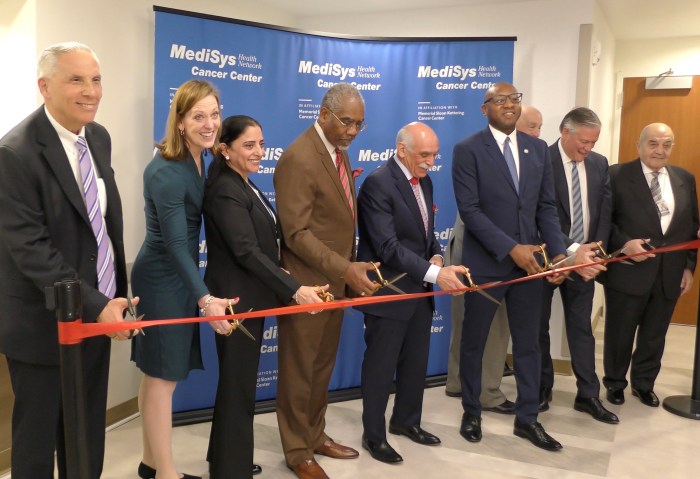Last week, President Barack Obama’s landmark legislation to supply health care to most Americans was upheld by a 5-4 Supreme Court ruling, and soon many uninsured Queens residents will have access to doctors, hospitals and preventive medicine.
The constitutionality of the Affordable Care Act (ACA), which was passed in 2010, had been questioned by lawmakers because the law mandated that all Americans have health care or pay a fee.
However, Chief Justice John Roberts, who was appointed by former President George W. Bush, gave the surprising tiebreaker vote to upholding the law, deeming the penalty a tax, which Congress is normally allowed to enact.
“The courts looked at it in a constitutional manner and agree that what we did was constitutional,” said Congressmember Gregory Meeks, who represents parts of southeastern Queens. “The president’s achievement and what the Democratic controlled congress did is the right thing for America.”
Officials said the historic decision from the nation’s highest court will especially affect locals.
“The Supreme Court ruling to uphold significant sections of the patients’ bill of rights is a momentous feat for the future viability of Queens’ health care,” said Assemblymember Andrew Hevesi, who sits on the Health Committee. “It is my hope that the reforms contained in the patients’ bill of rights will not only ensure the health and well being of our borough’s residents, but also enable us to expand our health care system in Queens”.
However, directly after the courts’ decision, local Republicans sided with party leaders, disclaiming the law’s benefits, and continuing bipartisan bickering over the controversial issue.
“Like most Americans, I am disappointed with the Supreme Court’s ruling today. ‘ObamaCare’ is expensive, expansive and unpopular,” said Councilmember Dan Halloran. “Even in upholding ‘ObamaCare,’ the Supreme Court held that it’s a tax — the biggest tax increase in American history. That’s the last thing we need in these economic times.”
But Obama later defended the mandate, citing two reasons.
“First, when uninsured people who can afford coverage get sick, and show up at the emergency room for care, the rest of us end up paying for their care in the form of higher premiums,” Obama said. “And second, if you ask insurance companies to cover people with pre-existing conditions, but don’t require people who can afford it to buy their own insurance, some folks might wait until they’re sick to buy the care they need — which would also drive up everybody else’s premiums.”
To many people, ACA may seem confusing, because the law covers a significant range of changes in the insurance industry.
To break it down, the law forces insurance policies to become more secure and flexible for citizens that already have insurance.
Going forward, companies can’t impose lifetime limits on care or charge higher rates for children with pre-existing conditions.
Also, young adults that already receive coverage through their parents — approximately 77,800 of which are in New York — can remain on those plans until the age of 26.
In addition, starting in August, insurance companies will also be required to cover women’s preventive services, including contraception.
The law especially targets the more than 30 million Americans citizens that don’t have insurance by offering cheaper options.
These options and their prices will be clear by 2014, when each state will set up a range of affordable insurance choices in a marketplace known as “exchanges.”
With more than 2.7 million currently uninsured residents in New York, Governor Andrew Cuomo established the New York Health Benefit Exchange in April, which will affect more than one million uninsured New Yorkers.
“We will continue to move forward with implementing the health exchange that will lower coverage costs for New York’s businesses and help ensure that uninsured New Yorkers have access to health care,” said Cuomo after the court’s decision.
Through these exchanges, individuals with pre-existing conditions will not be charged higher rates and they won’t lose coverage if they get sick.
All businesses, except those with fewer than 50 employees, are required to provide insurance to their workers.
But small businesses under the cutoff –340,000 of which are eligible in New York — that do offer insurance can quality for a 35 percent tax credit, which will increase to 50 percent in 2014 if they enroll through the exchanges.
Although the legislation has been upheld by the Supreme Court, officials in the Republican-led House of Representatives have vowed to trash the law in a vote on July 11, according to published reports.
Local Democrats are calling the ruling a sign that it’s time to move on.
“Republicans must act in the interest of Americans now, and put the politics aside,” Meeks said. “Instead of rhetoric about repealing the ACA, it is time for Republicans to work toward successful implementation.”
Politics aside, some locals in the business industry are saying now that the law has been upheld it’s time to work.
“The next three or four years is going to be a lot of work,” said Sher Sparano, president of the Benefits Advisory Service. “Now we have gotten over the hurdle of ‘does the law exist,’ now we have to roll up our sleeves and figure out the details of how the employers and employees move forward.”































